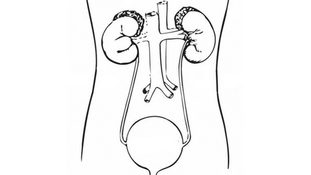Bladder cancer stages: © pikovit – stock.adobe.com
Treatment with the combination of durvalumab (Imfinzi) and standard-of-care Bacillus Calmette-Guérin (BCG) induction and maintenance therapy led to a statistically significant and clinically meaningful improvement in disease-free survival (DFS) when used for the treatment of patients with high-risk non-muscle invasive bladder cancer (NMIBC) vs BCG induction and maintenance therapy alone, according to high-level data from the phase 3 POTOMAC trial (NCT03528694).1
While the study was not statistically powered to formally test overall survival (OS), a descriptive analysis showed there to be no detriment.
Safety and tolerability findings of the combination of durvalumab plus BCG induction and maintenance therapy were consistent with the known safety profiles of each agent individually. There were no new safety signals seen in the study. Further, adding durvalumab to the standard treatment did not make it harder for patients to finish their full course of BCG therapy in both the initial and ongoing phases.
“These exciting data show that adding 1 year of durvalumab to the current standard treatment significantly extends the time patients live without high-risk disease recurrence or progression. While most patients with non-muscle invasive bladder cancer are treated with curative intent, 80% see their disease return, and almost half may require life-altering surgery to remove the bladder, underscoring the urgent need to improve treatment,” said Maria De Santis, MD, head of the interdisciplinary uro-oncology section at Charité Universitätsmedizin Berlin, Germany, and a principal investigator in the POTOMAC trial, in a press release.
The study’s second experimental group, which received durvalumab with only the initial phase of BCG, did not achieve its goal of improving how long patients lived without their disease returning when compared with standard, full BCG treatment.
These results will be presented at a future medical meeting and given to global health authorities.
“The positive results for Imfinzi in the POTOMAC trial represent a significant advance that will potentially allow more patients with early-stage bladder cancer to benefit from this important immunotherapy,” said Cristian Massacesi, chief medical officer and oncology chief development officer, AstraZeneca, in the press release. “Building on the NIAGARA [NCT03732677] data, this outcome demonstrates our strategy of bringing novel therapies to patients with early-stage disease where there is the greatest potential for long-term benefit.”
Background and Approvals of Durvalumab
Durvalumab is a human monoclonal antibody that targets the PD-L1 protein on cancer cells. The agent is able to block the interaction of PD-L1 with the PD-1 and CD80 proteins, helping the immune system recognize and attack the tumor by overcoming the tumor’s ability to hide.
Currently, durvalumab is an FDA-approved treatment, and it has also gained approval in other countries for the treatment of patients with muscle-invasive bladder cancer (MIBC). Data from the phase 3 NIAGARA trial support the agent’s approvals.2
Durvalumab continues to be investigated for the treatment of both early- and late-stage bladder cancer in various treatment combinations, including in patients with MIBC who are ineligible or refuse to take cisplatin and in locally advanced or metastatic disease.
About the POTOMAC Trial
POTOMAC is a large, international phase 3 study that randomly assigned 1018 patients with high-risk, early-stage bladder cancer who had not received BCG before and had surgery into 3 groups.3 In the randomized, open-label, multi-center, global trial, 1 group received durvalumab plus the standard full BCG treatment. Another received durvalumab plus only the initial phase of BCG. The third group received the standard full BCG treatment alone.
This trial is being conducted at over 120 sites in 12 countries, including Canada, Europe, and Asia. Enrollment was open to patients aged 18 years and older who were BCG-naive with a local histological confirmation of high-risk transitional cell carcinoma of the urothelium of the urinary bladder confined to the mucosa or submucosa. Patients must also have had complete resection of all Ta/T1 papillary disease prior to randomization, have had no prior radiotherapy for bladder cancer, and have had no previous exposure to immune-mediated therapy. Patients who have previously been treated with anticancer vaccines are excluded from the study.
The primary end point of the study is to determine the efficacy of durvalumab plus BCG induction and maintenance combination therapy vs standard of care in terms of DFS in patients with NMIBC.
Secondary end points of the study included comparing the durvalumab plus initial BCG group to the full BCG group in terms of recurrence-free survival, as well as looking at OS after 5 years and the safety of the treatments with durvalumab. DFS, assessing disease-related symptoms and health-related quality of life, patient-reported treatment tolerability using specific PRO CTCAE symptoms, and pharmacokinetics are secondary end points of the trial.



